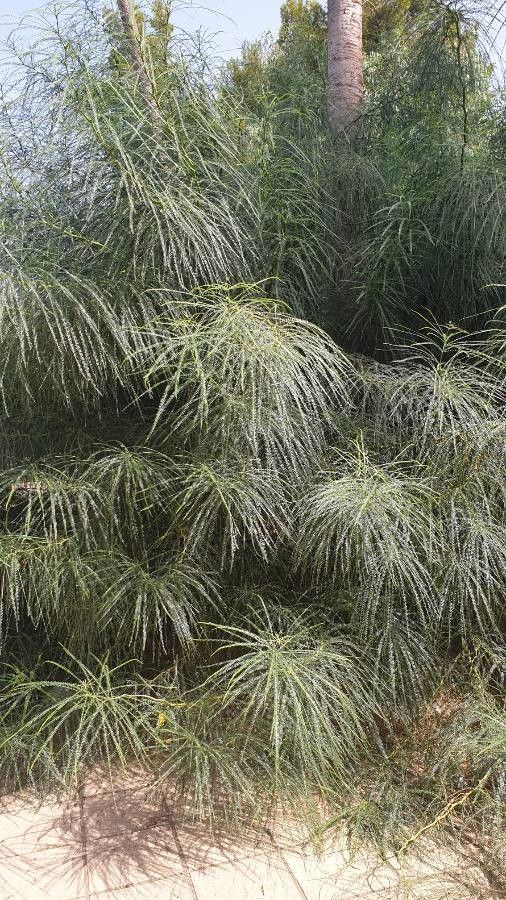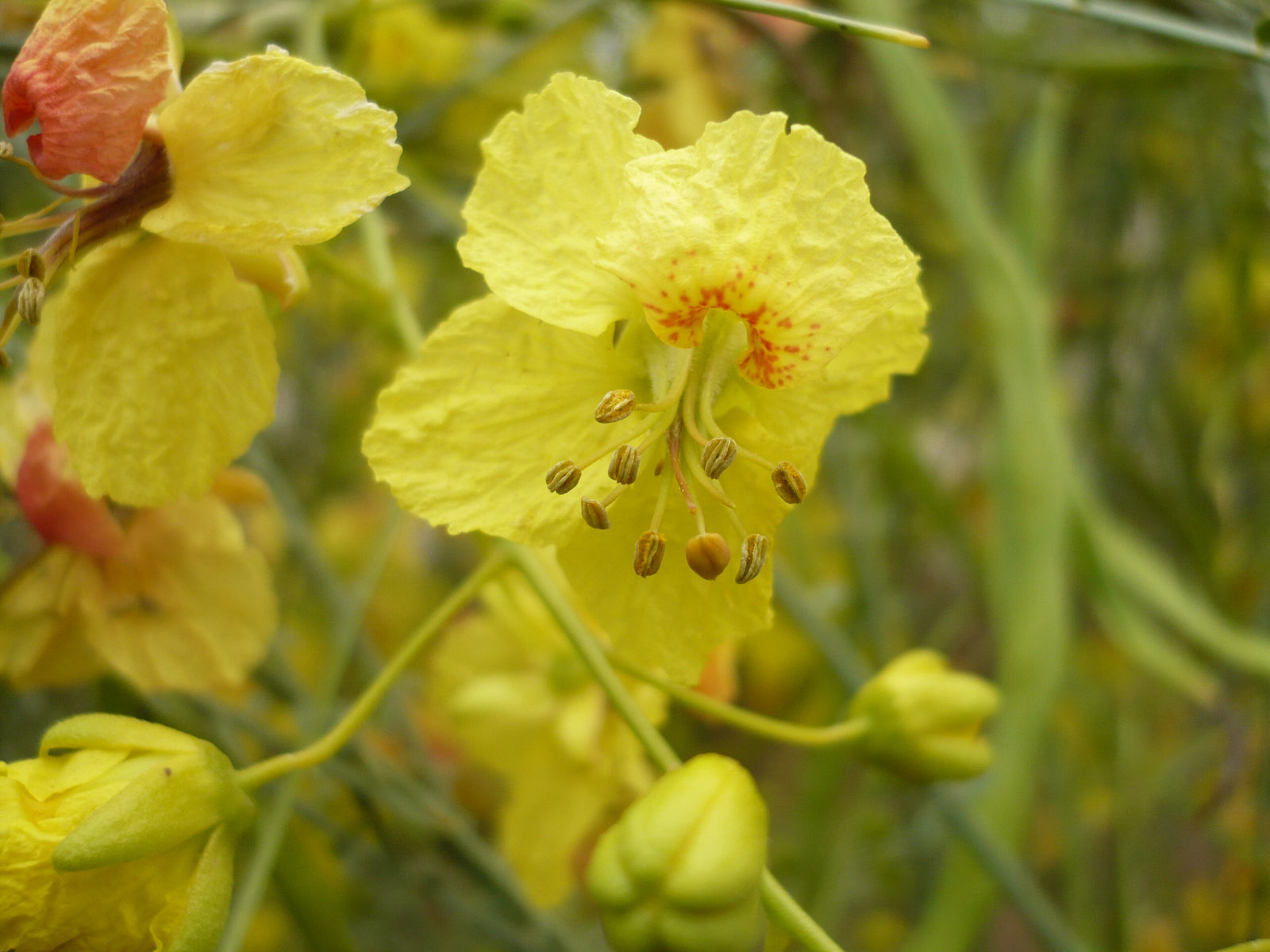Jerusalem thorn, Mexican palo verde
parkinsonia aculeata
Also known as: ["Jew's Thorn","Horsebean","Cascalote"]
Overview
A deciduous, drought-tolerant tree or shrub native to the Americas, characterized by green bark, yellow flowers, and spiny branches.
Benefits & Perks
["drought tolerant","fragrant flowers","wildlife attractant (bees, butterflies, birds)"]
Botanical Classification
| Phylum: | Magnoliophyta |
| Class: | Magnoliopsida |
| Order: | Fabales |
| Family: | Fabaceae |
| Genus: | Parkinsonia |
| Botanical Name: | Parkinsonia aculeata |
Plant Characteristics
Basic Information
- Category: Trees
- Suitable Location: xeriscaped garden or arid landscape
- Suitable For:
- Is Weed: No
- Allergenicity: low
Environmental Needs
- Climate: {"temperatureRange":"15–45°C"}
- Hardiness: {"zones":"8–11"}
- Misting: rarely required
- Drainage: Fast-draining to prevent root rot.
- Soil Type: Well-draining, sandy or loamy soil with some organic matter.
Maintenance Level
- Maintenance Level: low
- Toughness Level: high
- Pruning Frequency: Annually or as needed to remove dead or overgrown branches.
- Pruning Intensity: Moderate; remove up to one-third of old growth if necessary.
Care Details
Ideal Sunlight Coverage:
Full sun (6–8 hours of direct sunlight daily); tolerates intense summer sun but benefits from partial shade in extreme heat.
Sunlight Tolerance Tips:
Acclimate new plants gradually to full sun; protect from harsh afternoon sun in hot climates; ensure good air circulation to prevent sunburn.
Care Requirements
Care Difficulty
easymoderate
Sunlight
full sun
Full sun is essential; provide shade during extreme heat; rotate plants for even growth.
Watering
every 2–3 weeks during active growth, less frequently in winter
Water thoroughly but infrequently to encourage deep root growth; allow soil to dry between waterings; avoid overwatering, especially in winter.
Soil
well-drained, sandy or loamy soil
pH: Slightly acidic to neutral (pH 6.0–7.5).
Ensure excellent drainage; avoid heavy clay soils; amend with organic matter if needed.
Temperature
Thrives in warm conditions (65–100°F or 18–38°C); prefers hot summers and is drought-tolerant once established.
Protect from frost; water deeply in hot weather; adjust care based on seasonal temperature shifts.
Fertilizing
every 3–4 months with balanced, slow-release fertilizer
Fertilize sparingly; avoid high-nitrogen formulas; apply before new growth begins.
Propagation
Methods
Stem cuttings or seed; stem cuttings are faster and more reliable.
Step-by-Step Propagation Guide
- Take 4–6 inch cuttings.
- Remove lower leaves.
- Dip in rooting hormone.
- Plant in medium.
- Keep moist and warm.
Best Time: Spring or early summer when the plant is actively growing.
Environment
Warm (75–85°F or 24–29°C), high humidity, and bright indirect light.
Medium
Well-draining mix of perlite and peat moss or cactus mix.
Hormone
Rooting hormone is recommended for faster rooting.
Timeline
Roots may develop in 4–6 weeks; establish in 3–6 months.
Tools Needed
Pruning shears, rooting hormone, small pots, well-draining medium.
Quick Tips
Use fresh cuttings; keep consistently moist; provide bottom heat for faster rooting.
Pruning & Repotting
Pruning Guide
Method
Selective thinning and heading back to shape the plant and improve air circulation.
Pruning Plan
Prune to maintain shape, remove dead wood, and encourage bushier growth; best done in late winter or early spring.
Tools
Pruning shears, loppers, gloves, disinfectant.
Checklist
Disinfect tools; prune dead or diseased wood; shape the plant; clean up debris.
Repotting Guide
Best Season
Early spring before new growth begins.
Pot Size
Increase pot size by 2–3 inches in diameter; ensure good drainage.
Method
Remove plant gently; trim roots if crowded; repot in fresh, well-draining soil; water lightly.
Suggestions
Repot every 2–3 years or when roots fill the container; beneficial for young plants to encourage growth.
Checklist
Choose appropriate pot; prepare fresh soil; handle roots carefully; water after repotting.
Advanced Care Tips
Watering Mastery
Watering Checklist
Check soil moisture before watering; water deeply at the base; ensure proper drainage; adjust frequency seasonally.
How to Apply Water Properly
Water directly at the root zone until the soil is moist to a depth of 6–8 inches; ensure water drains freely; water early in the morning to minimize evaporation.
Watering Schedule Tips
Water deeply once every 7–10 days during active growth in spring and summer; reduce frequency to every 3–4 weeks in fall and winter. Adjust based on rainfall and soil dryness.
Soil Improvement
Add perlite or coarse sand to improve drainage; incorporate compost for fertility.
Temperature Stress Management
Signs of Temperature Issues
Leaf drop or wilting in extreme cold; stunted growth or yellowing in prolonged heat without water.
Cold Stress
Susceptible to frost damage; cold temperatures can cause leaf drop and slow growth; may die back in severe cold.
Solution: Plant in a sheltered location; protect with frost cloth in winter; avoid overwatering in cold weather.
Hot Stress
Leaves may curl or drop during extreme heat if water is scarce; growth may slow.
Solution: Provide supplemental water during heatwaves; mulch to retain soil moisture; ensure good air circulation.
Fertilizing Guide
Fertilizing Checklist
Use balanced fertilizer; apply in spring; avoid over-fertilizing; water after application.
Fertilizing Method
Use a balanced, slow-release fertilizer in early spring; avoid excessive nitrogen; reduce or stop fertilizing in fall and winter.
Common Problems & Solutions
Toxicity Warning
Cats
Slightly ToxicCats are susceptible to the toxic effects of Parkinsonia aculeata, particularly from seeds and bark, which contain quinolizidine alkaloids. These substances can cause gastrointestinal distress and mild neurological effects in felines.
⚠️ Symptoms:
🌿 Toxic Parts:
⚡ Toxic If:
if eaten
Dogs
Slightly ToxicIn dogs, ingestion of Parkinsonia aculeata seeds and bark can lead to gastrointestinal upset and mild neurological symptoms due to the presence of quinolizidine alkaloids. These compounds disrupt normal digestive and nervous system functions.
⚠️ Symptoms:
🌿 Toxic Parts:
⚡ Toxic If:
if eaten
Humans
Slightly ToxicParkinsonia aculeata contains quinolizidine alkaloids, particularly sophorine, which can cause neurological and gastrointestinal disturbances upon ingestion. The alkaloids interfere with neurotransmitter function and may lead to metabolic imbalances.
⚠️ Symptoms:
🌿 Toxic Parts:
⚡ Toxic If:
if eaten
Frequently Asked Questions
Q: Is Parkinsonia aculeata suitable for xeriscaping?
A: Yes, it is highly drought-tolerant and well-suited for xeriscaping.
Q: Does Parkinsonia aculeata attract wildlife?
A: Yes, it attracts bees, butterflies, and birds with its flowers and seeds.
Q: Is Parkinsonia aculeata toxic to pets?
A: It is mildly toxic to dogs and cats if ingested.
Quick Reference
| Family: | Fabaceae |
| Care: | easy |
| Light: | full sun |
| Water: | every 2–3 weeks during activ |
Get Expert Care Tips
Download the Plantious app for personalized care reminders and plant identification!
Google Play App Store








